A string of lakes located in the Trinity Mountains
Trip date: August 11, 2017

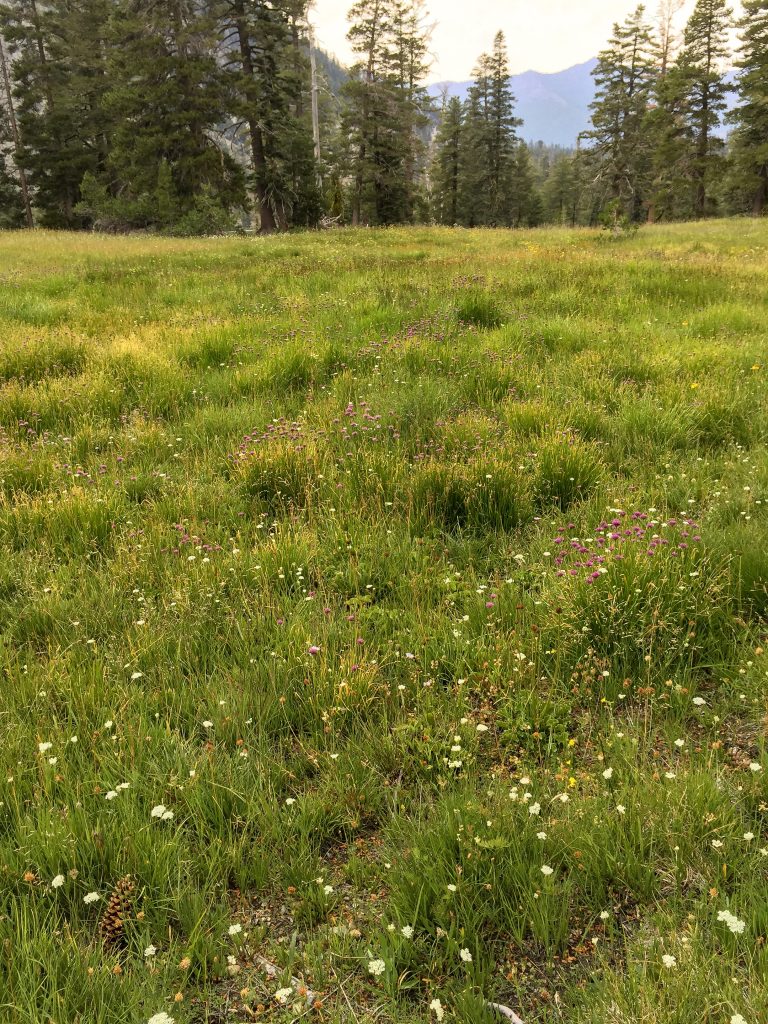

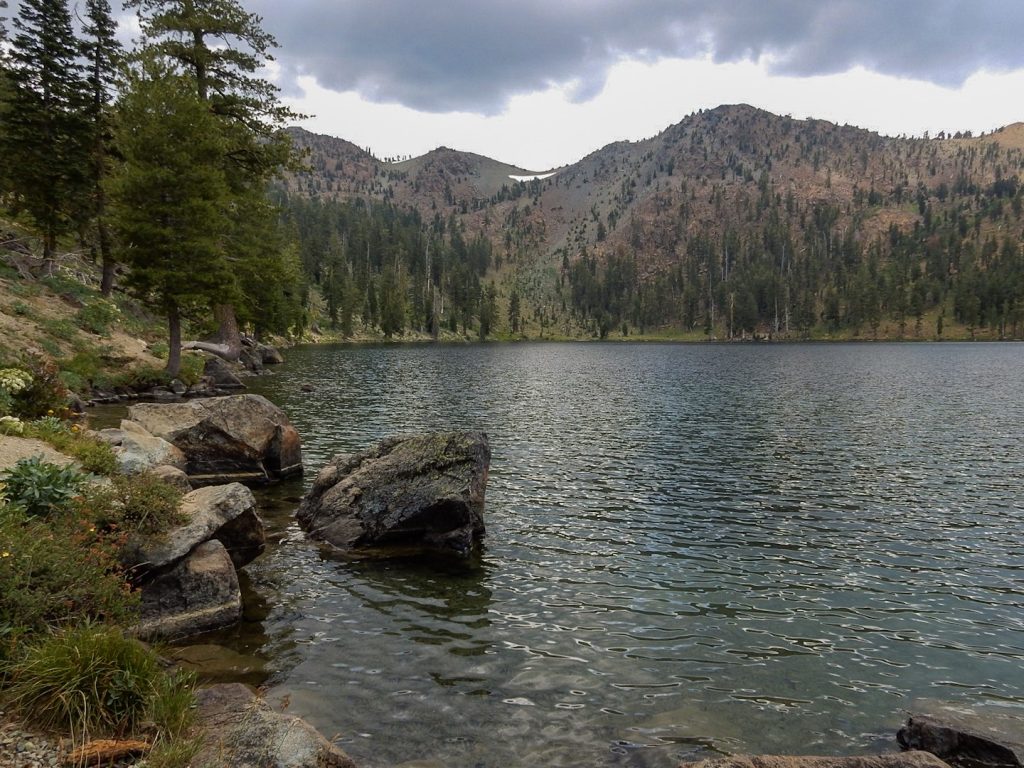

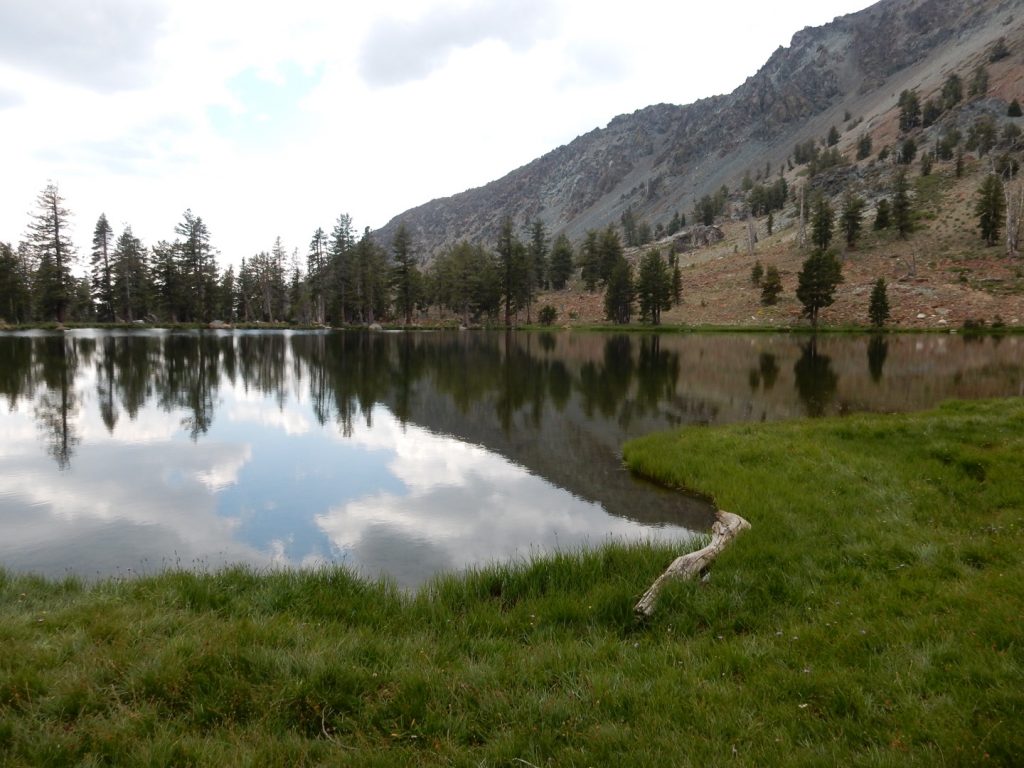
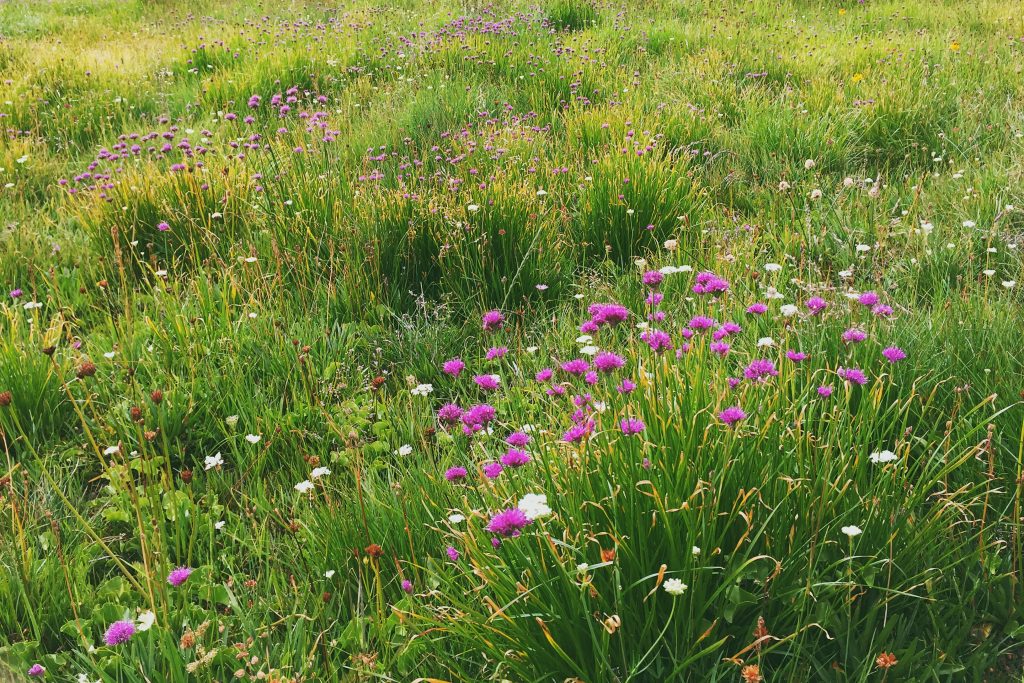







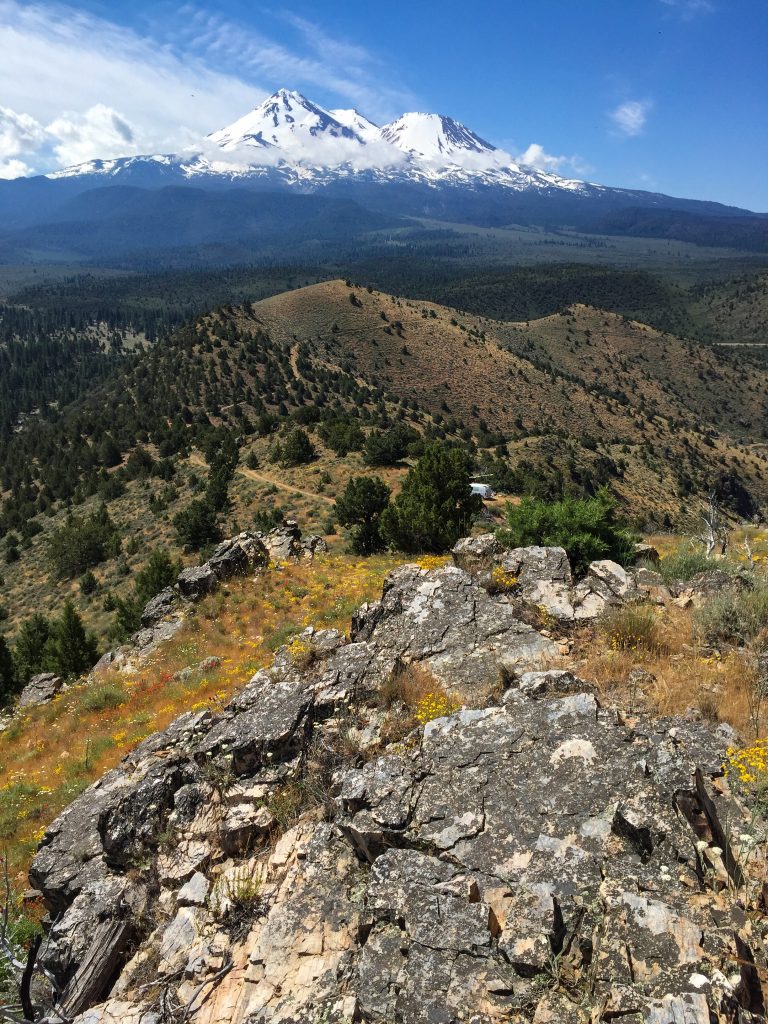
Yellow Butte is a hill on the north side of US Highway 97 about 12 miles northeast of Weed. Unlike other nearby peaks which are some kind of volcanic feature (dome, cinder cone or shield volcano), Yellow Butte is an uplifted complex of intrusive igneous and metamorphic rocks. This makes for some interesting quartzite outcrops on the top of the hill, and the unexpected diorite pluton along the first third of this route I hiked today.
Yellow Butte is actually more of a ridge, with three distinct peaks, the northernmost being the highest. The route I’ve seen described elsewhere is a 3 mile round trip starting inside a Forest Service gate alongside Highway 97 that traverses the west side of the hill. Because my available time was short, I chose a shorter route on the east side of the hill on Yellow Butte Road, a narrow, dusty two-track off of 97. This route proceeds up to saddle area between the middle and north peaks. Truth be told, both routes to the peak are old two tracks themselves – in fact, one could drive to the summit in a 4WD high clearance vehicle. But, as I got near the top, I encountered a guy camping in a beat-up, 30 year old, 2WD, low clearance Chevy van at the top – so don’t I guess I don’t know what I’m talking about.
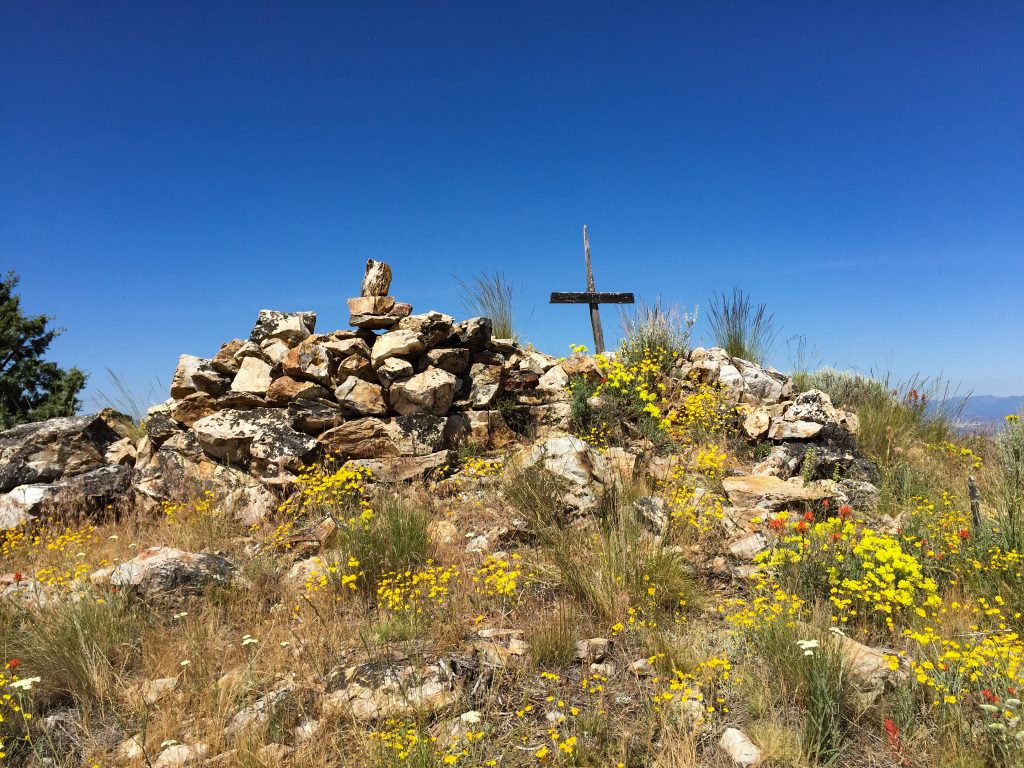
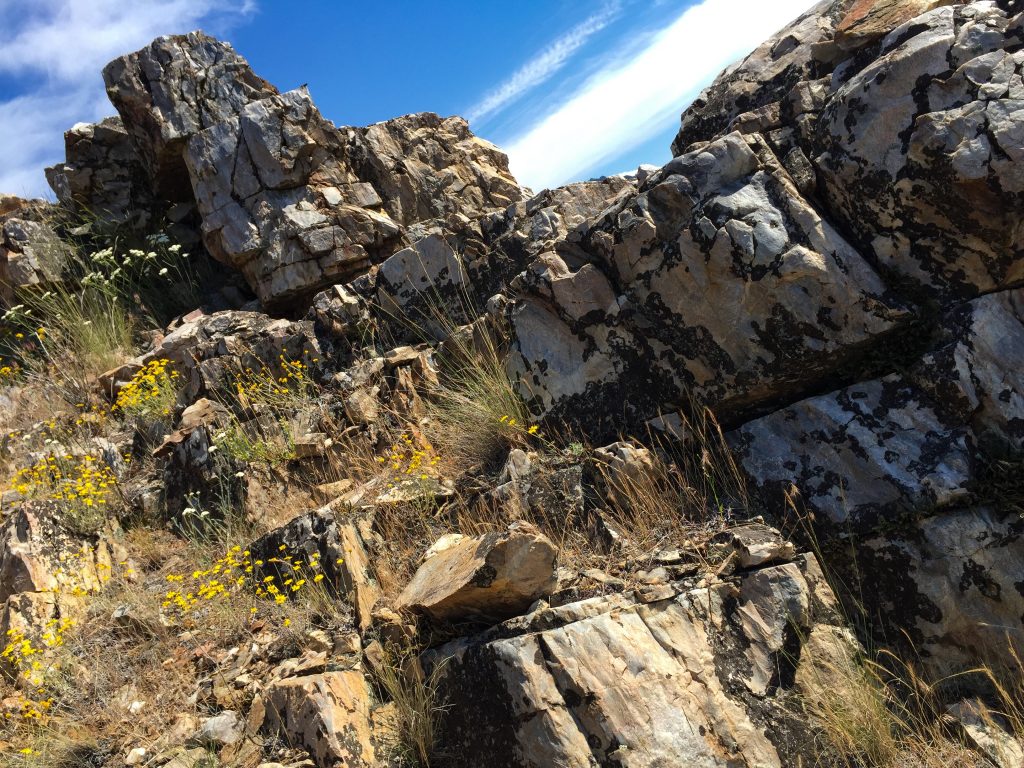
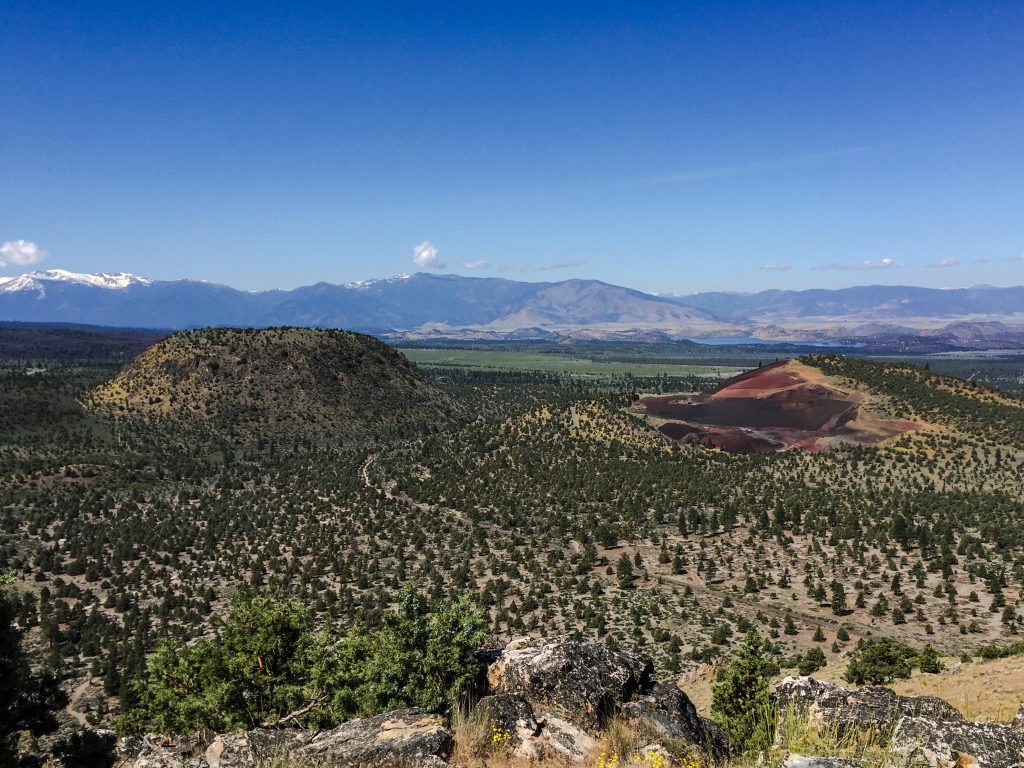
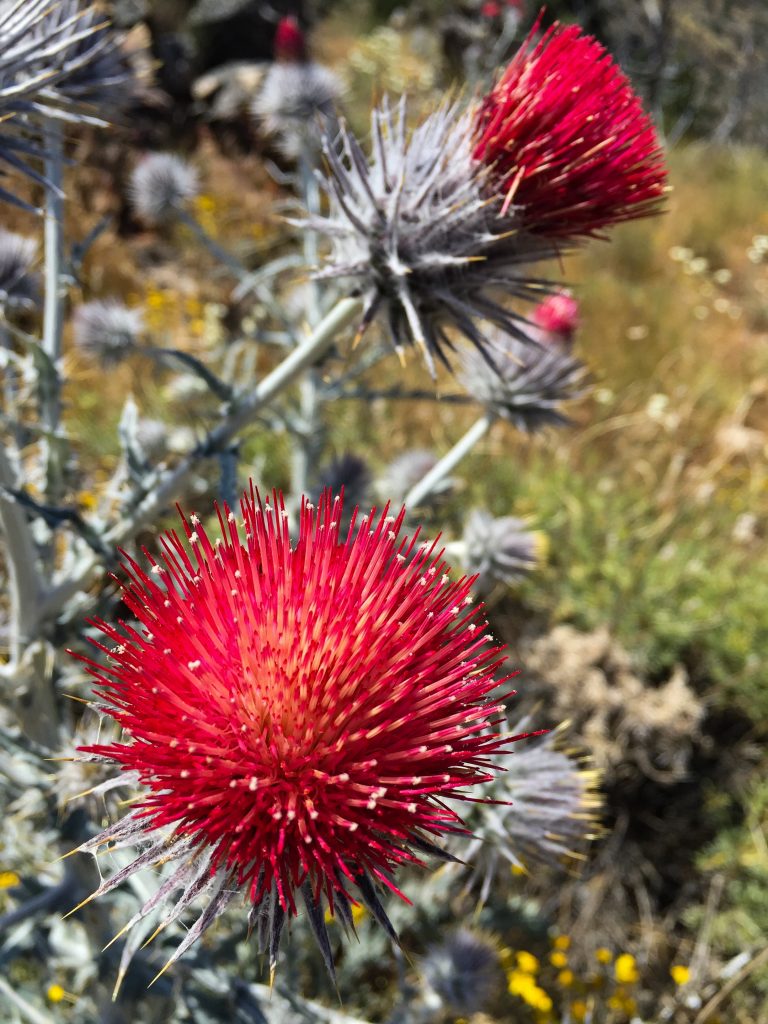
I could not locate a survey triangulation mark indicated on some older topo maps. Neither could I find a summit log, so I left a new one behind.
Trip time is about 25 to 30 minutes each way.
For an excellent discussion of the geology of the lower Shasta Valley, see a masters thesis by Joseph Holliday, “The bedrock geology of the southeastern Shasta Valley, Siskiyou County, California”
Photos from a hike this past Memorial Day on Haystack, a volcanic dome north of Mount Shasta (see the previous post “Haystack” for a brief description of the Haystack hike).
Haystack is a volcanic feature rising above US Route 97 11 miles northeast of Weed. The peak offers wonderful views of Mount Shasta to the south, the Trinity Mountains to the east, and the Mount Shasta Valley to the north. The trail is an overgrown 4WD trail to the top. Good parking is just off the highway inside a Forest Service gate. One walks about .4 mile before reaching the actual trail that starts the climb up the east flank of Haystack. The short climb takes a moderate effort to reach the top. The trail circles the rather flat, open top. Vegetation is typical high desert scrub with the scattered juniper tree. There is a high point marked with a cairn with a survey mark underneath and a summit log. The summit log revealed that Haystack is visited every few days by hikers. The distance from the parking area to the high point is about one mile.
This was my first backpacking trip in over 10 years. I went with my buddy Joe, who’s about the same age as I, and we took the 15 year old son of a friend who couldn’t go due to back problems. Ryan is a good kid, in great shape, and has a great attitude. And who has a fondness for aluminum foil.
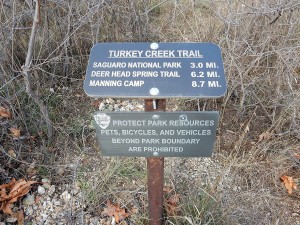
Our destination was the Spud Rock Spring campsite by way of the Turkey Creek Trail, located in the eastern side of the Rincon Mountains, in the Saguaro Wilderness Area of Saguaro National Park. From the eastside of Tucson, it’s about a 2 hour drive east towards Benson, getting off Interstate 10 at Mescal. From there, you head north into the Coronado National Forest to the Happy Valley area on Forest Service road 35. If you don’t have a high clearance four wheel drive, you have to park at Miller Flat and walk an extra 1.5 miles or so up FS 4408; otherwise, you can proceed through a gate and park at the end of FS 4408 to start the hike.
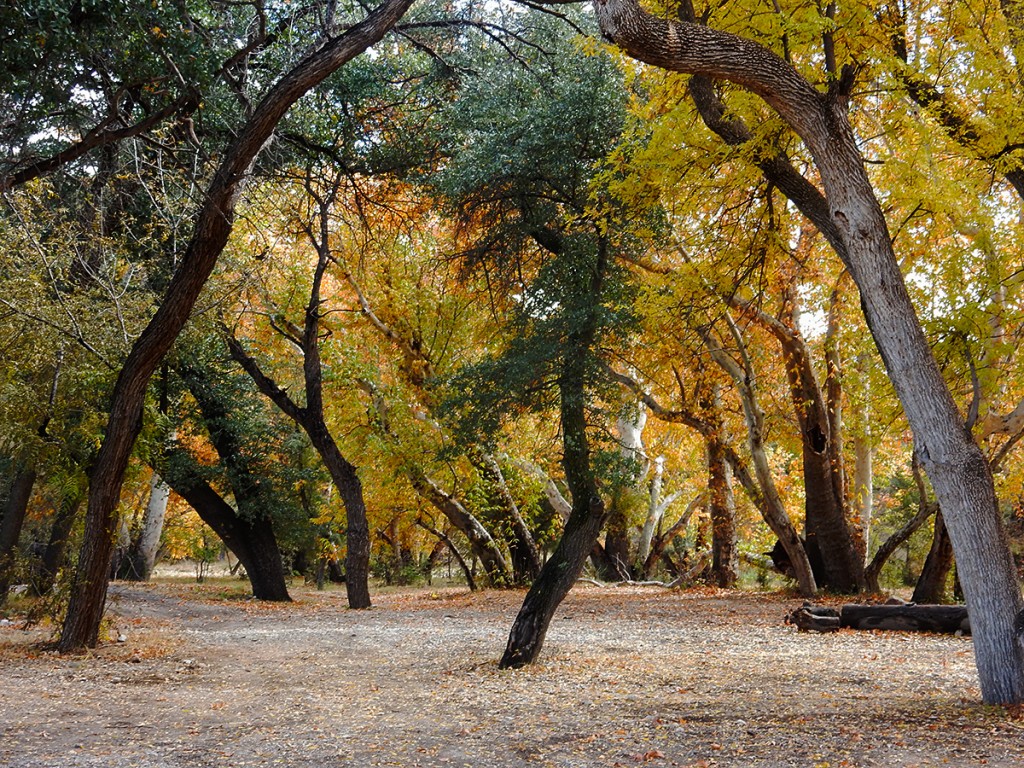
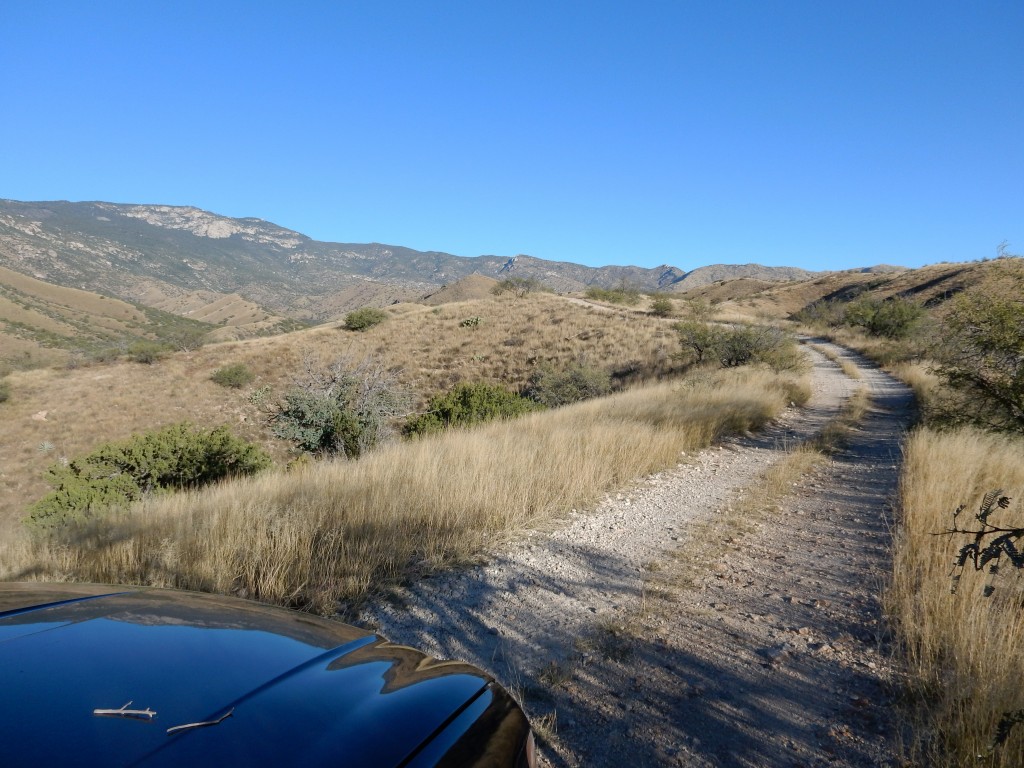
We left Tucson at 6:30 on Friday morning and arrived at the trail head in Happy Valley around 8:20 AM. Joe has a Jeep Liberty, so we were able to get the end of Forest Service road 4408 to start our journey, rather than having to park down the ridge and hike another 1.5 miles in. The weather was great, though still chilly at this time of morning – 36 degrees and clear. We hit the trail at 8:45, quickly shedding a couple of layers as we warmed up from the sun and exertion.
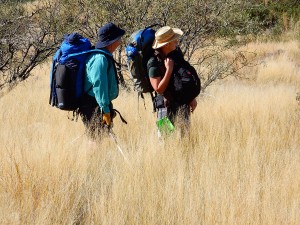
For the first couple of miles, the trail climbs slowly through savanna grasslands and oaks. After that, it was a slog for pretty much the next 3 miles. It was like doing Blackett’s Ridge in Sabino Canyon twice. We stopped frequently to catch our breath, as well as to enjoy the view and take photos. At Mud Hole Spring, we ate lunch and took a half hour nap.
It was evident that this trail doesn’t get much use. It was overgrown almost all the way up, and in many spots, felled trees crossed our path. Near the end, about 3/8 mile from Spud Rock Spring, we spent about 20 minutes trying to follow the trail, due to overgrowth and debris on the trail. We finally arrived at the campsite at 5 PM. Of the three sites available, we made ours nearest the pit toilet and the bear box, which served double duty as a camp table. There was ample firewood about, but the no water at the spring, just a wet bog, surrounded by a large grove of aspen trees. Even if there had been a flow, the ranger had told Joe it was not good for drinking.
The ranger had also told Joe that we would be by ourselves on Friday night, but that the other two sites would be occupied on Saturday. We thought this odd, given it was November, it was the far side of the Rincons, and the threat of inclement weather loomed.
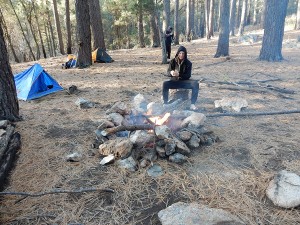
All of us had frozen meat with us (2 steaks and 2 chicken breasts) that had thawed out nicely during the day. We cooked these on small wire we had brought along, and supplemented these with baby carrots, dinner rolls, potatoes, and nuts. Ryan had not brought any plateware. Rather, he had a roll of aluminum foil. He took a flat piece of rock, and covered it with foil, using this as his plate. After dinner we made hot chocolate while a roaring fire danced before us. Ryan did not have a cup. Using mine as a mold, he fashioned one out of foil. We called it a night around 7:30. The night time temperature was quite pleasant, with almost no wind during the night.
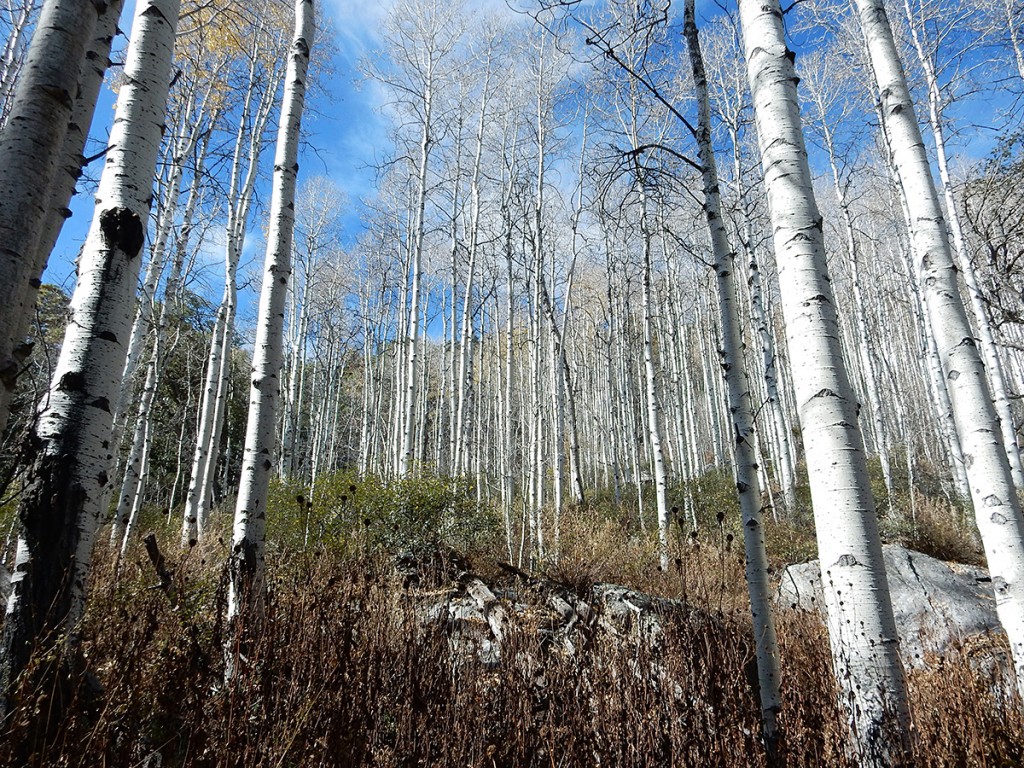
Saturday morning found us getting up around 7 AM. Quickly Ryan made a fire (he being 15, the fire was much larger than it needed to be, but boys will be boys) and we went about making coffee and breakfast. We spent most of the morning sitting around the fire, taking a nap mid morning, before getting our act together and heading over to Devil’s Bathtub to procure water. We missed the trail for the most direct route, taking a route that led us to a farther south meeting with the Heartbreak Ridge Trail, causing us to have to climb back up 500 feet, rather than staying fairly level.
At Devil’s Bathtub, we filled our bottles and bladders, ate lunch, and napped again in the warm rays of the sun on the gently sloping granite at the top of the falls. We didn’t go to the bottom of the falls, as we just didn’t want to do any more climbing than we had. After about an hour and a half, we made our back on the correct route to Spud Rock Spring.
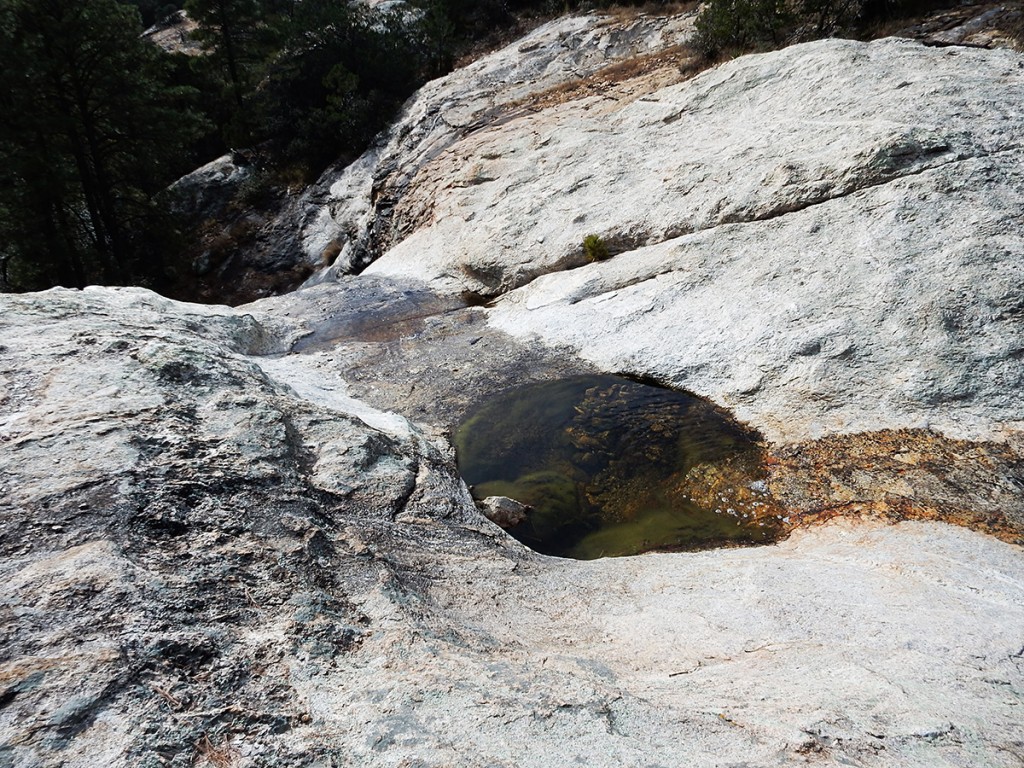
As evening approached, we prepared dinner and built another roaring fire. The temperature dropped, but it was still comfortable. Ryan threatened to make a jacket out of, you guessed it, aluminum foil. Joe and I convinced him that he would be better served by just climbing into his sleeping bag. The skies overhead were clear, with no wind whatsoever. We began to doubt any arrival of rain during the night. Too, no other campers appeared either, though around 8 PM both Joe and myself thought we heard voices in the distance, but we never saw any lights or smelled smoke from other fires. About that time, we called it a night.
The rain came at 1:45 AM on Sunday.
It drizzled most of the night. Joe and I stayed dry, but neither of us noticed that Ryan had not put a rain fly on his tent, so he got a bit wet. By the time we got up at 7, the rain had abated, allowing us to eat some breakfast bars and break camp without too much fuss. We made our way out at 8:25 AM.
To make your way in or out of Spud Rock Spring, you climb a small ridge. As we went over and down that ridge, we came across 5 women in 3 tents in the area of the poor trail marking/overgrowth/felled trees. These were the hikers that held the permits for the other 2 sites, and the ones we had heard the night before. They had fought their way up the Turkey Creek Trail the day before, only to be stymied by the poor trail conditions and impending nightfall. The apparent leader walked over to us, inquiring about our campsite and water, as they had run out and were in the process of collecting what they could off their tent rainflies. Then, as panic set manifest itself in her eyes, she said “Perhaps this wasn’t the best trail or time to bring a couple of newbies on.” I think some friendships were damaged that day.
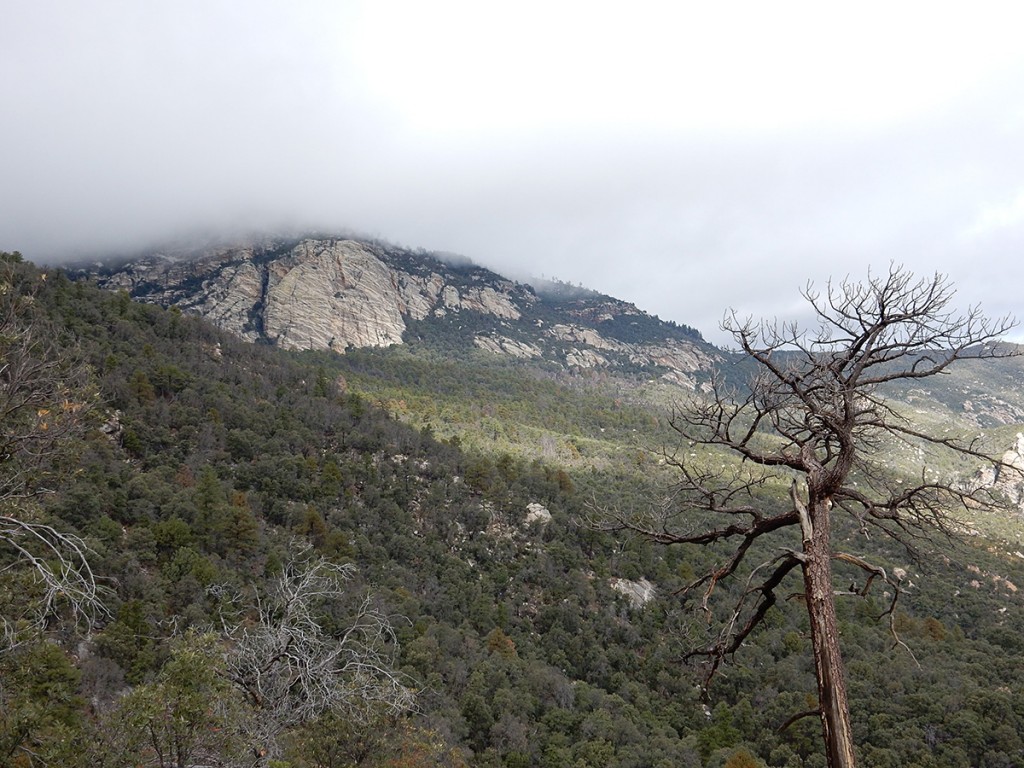
We made our way down through almost constant drizzle in four hours, without slipping and breaking anything. It was actually a pleasant experience. Sunlight shone upon us for the last mile, allowing us to dry somewhat before getting into the Jeep.

We enjoyed a late and large lunch at Reb’s Café in Benson before heading back to Tucson.
QUESTION: Why is Spud Rock Spring not even close to to Spud Rock? They are not even on the same ridge.
GEAR NOTES: I had checked out my old Coleman Peak 1 gas stove (dating back to 1982) last May, and it worked fine. When I tested it out before this trip, it was evident that it had developed bad seals, because the flames were burning yellow, and I couldn’t get new parts in time to rebuild it for use on this trip. So I bought an Optimus Crux Lite canister stove and the Optimus Terra Solo Cook Set. A small canister sits inside the cook set, along with the stove, and the cook set comes with a mesh stuff bag that doubles as a scrub cloth. The stove worked perfectly, and the cook set was just right for what I needed (making hot drinks and boiling water for instant oatmeal, a pouch dinner, and clean-up).
I also needed to get some shelter at the last minute. An offer of a borrowed bivy did not come through, and I didn’t want to pack my Mountain Hardware Optic 3.5 up the mountain, so I ended up getting a $39.99 1 person tent at Big Five at 8:55 PM on Thursday night. It worked great. It’s actually pretty well made for the price, with a generously sized mesh side panel to get in and out of, mesh panels on the other sides, a rainfly, and a fitted footprint. It was vented well, and I didn’t get any condensation. Both the tent and rainfly have good zippers, reinforced tie-down points, and the weight is 3 pounds. The factory sealed seams did not leak in the rain. Not a bad deal for back up or light duty bivy. Branded “Golden Bear”, one of the Rec-Out brands (Rugged Exposure, Columbus).
Scotts Knob is little hill (marked elevation of 2915 feet) on the eastern side of Tucson, about 1 mile east of the end of Speedway Boulevard, just north of the Saguaro National Park boundary, apparently on the property of the Tanque Verde Ranch (a local guest ranch). Unlike a couple of other hills in the area, this one is named on topographical maps, with an indicated elevation. (NOTE: On the Forest Service topo map below, “Scots Knob” with one “t” is used, but on all other maps it is spelled with two t’s)
My buddy Rob and I checked it out this Labor Day morning. Access is through a gate to the left of the TV Ranch sign; stay on any trail that goes right and hugs the boundary fence of the national park. You will eventually pass through a fence line that goes north/south – you will see the hill on your left. Proceed another 100 yards or so and another trail going north towards Scotts Knob will become apparent. Within a few minutes you will be on top of the summit. From the top you have nice views towards the Santa Catalina Mountains and Agua Caliente Hill to the north, and a great southwest sightline of the northwest face of Tanque Verde Ridge component of the Rincon Mountains.
Below are a few pictures from our exploration of Scotts Knob.
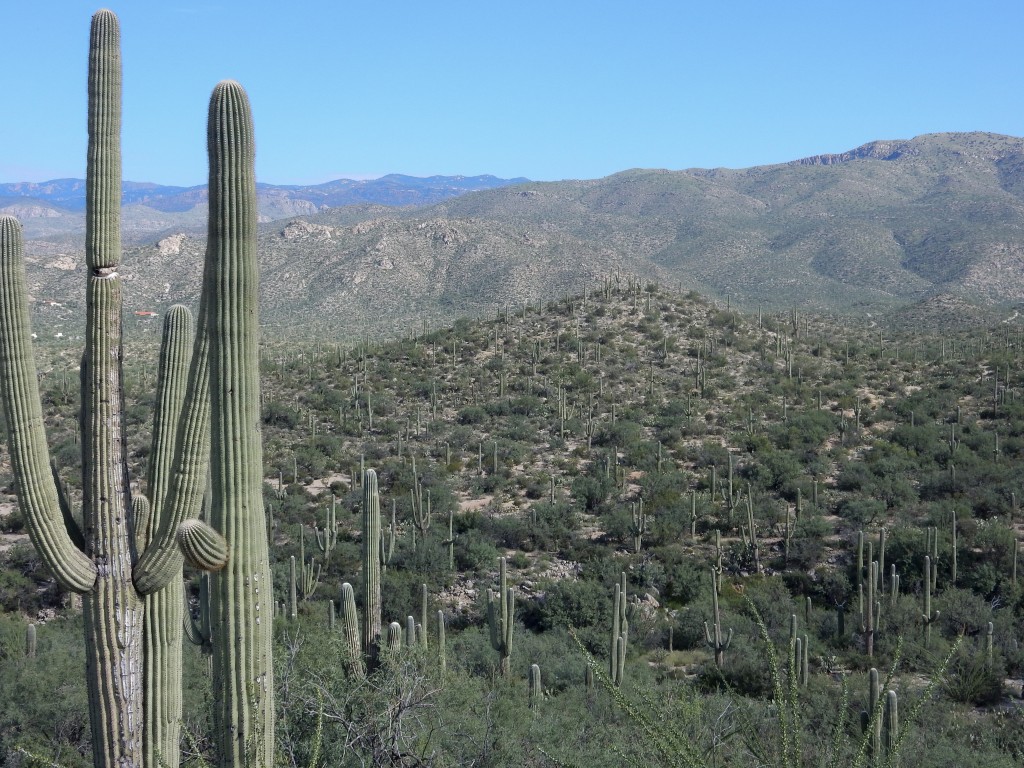
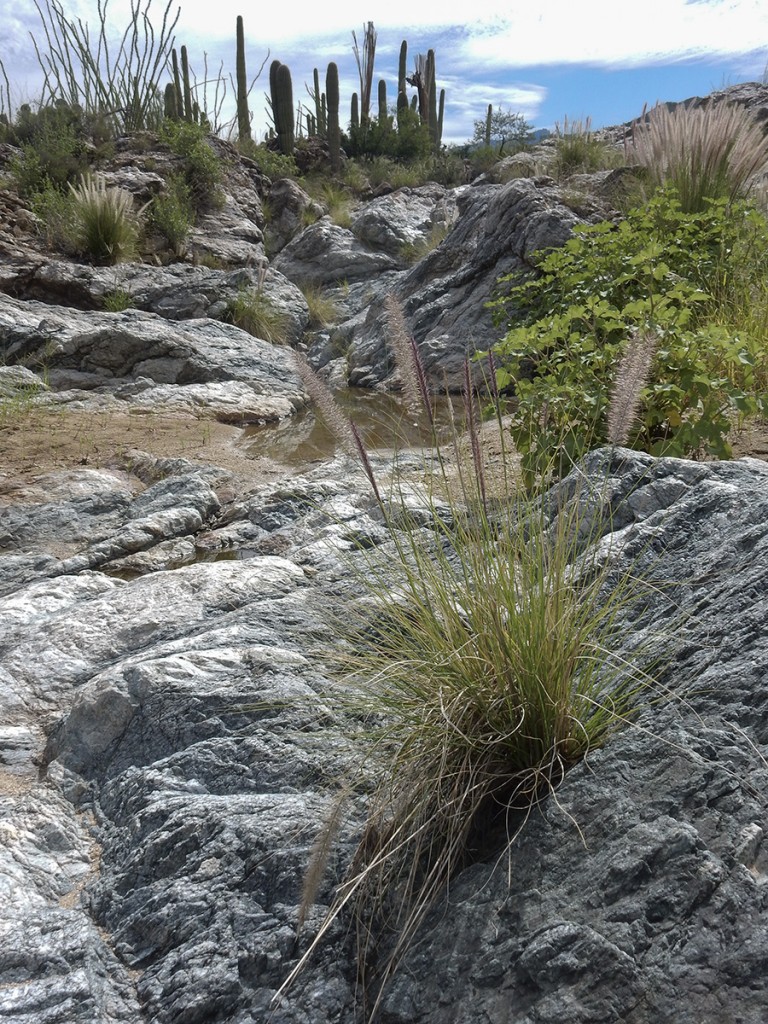
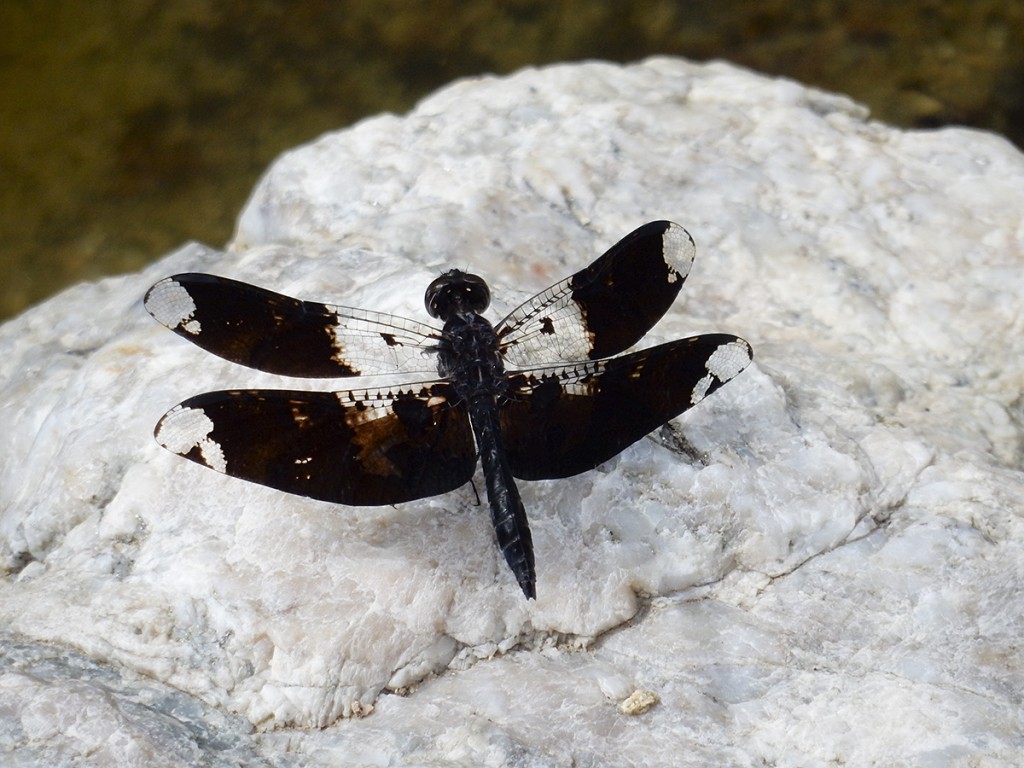

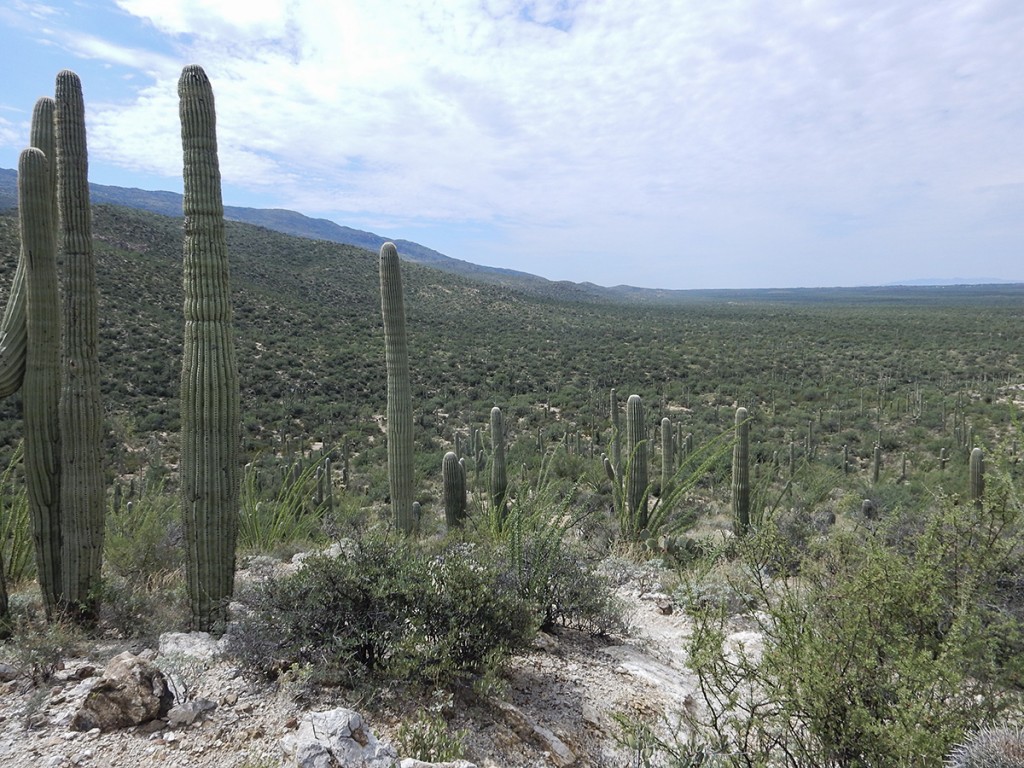
(Click on photos for larger view)
Madera Canyon, located in the Coronado National Forest on the west side of the Santa Rita Mountains, is about 46 miles from our house on the eastside of Tucson. The elevation of the canyon floor is at 3,562 feet, with the peaks of Mount Wrightson (9,452 feet) and Mount Hopkins (8,586 feet) looming overhead. The area around the Bog Springs Campground is a mix of grasses, cacti, oaks, mesquite, juniper, and piñon pine. Over 250 species of birds can be found here, making the canyon of the premier birding spots in the world. Eloise and I just visited Madera Canyon for the first time a few weeks ago. Already itching to do some camping, our tour of the Bog Springs Campground sealed the deal and within a few days I announced that we would camp for a night during the Memorial Day weekend.

Though we were only camping for one night, much preparation was needed. We hadn’t camped in over 10 years. Our gear was packed away in a number of boxes and crates, spread out between our garage and two storage units. It needed to inspected, tested, and organized. Since we had also started to think about family disaster planning, it only made sense to organize our gear so that most stuff served a dual purpose – recreation and survival. (At some point, I’ll cover some of my planning and organizing in another post.) Over the last couple of weeks, a number of runs were made to likes of Sports Authority, Big 5 Sporting Goods, Ace Hardware, and local favorites Summit Hut and Miller’s Surplus. Yes, gear lust took hold, but I managed to control myself. My OCD tendencies also manifested themselves, as a various number of containers (Plano Sportsman’s Trunks and Plano Field Boxes, and British-made Really Useful Boxes) were procured, filled, labeled, and sometimes stowed in one another. Batteries were marked with the date of purchase. New flashlights, lanterns, and other goodies were compared, bought, and assigned to the appropriate crate, box, bag, or fanny pack.
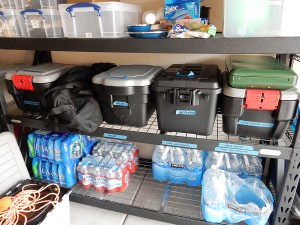
On top of the gear and food preparations, arrangements needed to made for someone to cover the business for the 36 hours or so while we were gone. Even though one day was a holiday, I already had a full day of transportation jobs on the schedule, plus someone had to take whatever calls would come in, schedule them, and if need be, assign drivers to cover them while I was gone. I was determined not to be tied to the phone, and there is almost no cell phone signal in the canyon anyway. Be what may, the guys needed to come through for me, and happily I can say, they did.
Since we were going into the canyon at the tail end of the holiday, I figured that most of the weekend campers would be departing the campground around noon or 1, and that if we got to the campground around 3, we would be able to find a spot before and if the facility filled up for the night. I had taken the Expedition into Goodyear for a last minute concern, and had the oil changed while I was there – so we didn’t start loading the truck until about 1:30 pm. Even so, having packed our clothes bags the night before, gathering the food from the fridge at the last minute, and putting the fully organized gear into the Ford, allowed us to hit the road an hour later at 2:30 pm. 46 miles and an hour later, we arrived at the canyon.
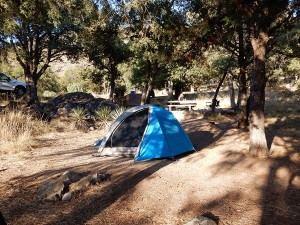 This was our first time camping here. A few campsites were available. The campground road is a single loop, which climbs as you go to the rear of the loop, and descends as you exit the campground. Campsites are spread out on the inside as well as the outside of the loop. We inspected the open spots, looking for privacy, shade, position of the picnic table and tent pad, and nearby neighbors. The single toilet facility is near the top of the loop. We picked a spot at the at the lower elevation, farthermost away from the bathroom. We had not really considered this until we had made camp and were done with dinner.
This was our first time camping here. A few campsites were available. The campground road is a single loop, which climbs as you go to the rear of the loop, and descends as you exit the campground. Campsites are spread out on the inside as well as the outside of the loop. We inspected the open spots, looking for privacy, shade, position of the picnic table and tent pad, and nearby neighbors. The single toilet facility is near the top of the loop. We picked a spot at the at the lower elevation, farthermost away from the bathroom. We had not really considered this until we had made camp and were done with dinner.
What does this all mean? Well, unlike ten years ago, I’m now on blood pressure meds (basically a diuretic), and having to drink massive amounts of water to fight off the formation of kidneys stones (especially after 12 stones in 2013 and the resulting 3 lithotripsies) and avoid dehydration in the desert, so careful consideration needs to given to access to facilities when choosing a campsite first and foremost, rather than realizing at midnight when your bladder is screaming for relief that it is a 1/4 mile walk uphill to el bano. And at 2:30 AM. And at 5 AM. And and …
So we improvised. I’ll leave it at that.
Since Eloise sleeps until noon or so, I thought I would get a short hike in after breakfast. In the campground is the trailhead for the “Dutch John Spring Trail.” The little Forest Service pamphlet describes this hike as a “moderately easy” trail. They lied. The trail has an 800 feet elevation gain in a mile, essentially straight up from the get go. This was my first real uphill hike in a couple of months, and I was not prepared for the pain that ensued. Plus, the trail was between 4,000 and 6,000 feet elevation, an altitude that I’m not used to. I’ve got a lot of work to do to get back into shape. Otherwise, it was a pretty hike up through the oaks, and I only came across 5 other hikers in the time I was out. I had to cut the hike short to get back to the camp by the time I had specified on the note I had left for my sleeping wife. I did not want Eloise to awaken and sending out the rangers looking for me because I hadn’t returned on time.

After she awoke, we ate a midday meal and broke camp. This went pretty quickly. We left the campsite around 2:30, and went over to the Santa Rita Lodge, where they have an observation deck, complete with seating and shade, where one can watch birds come to the feeders set up off the deck. Eloise and I are pretty new to birding, so we couldn’t identify everything, but it was enjoyable to watch the various hummingbirds, sparrows, finches, doves, and wild turkeys flit about. The term “pecking order” takes on a whole new meaning when watching so many species interact in a small space. Off to one side we observed several Acorn woodpeckers tussle over a hole on an electrical pole. Mexican jays and doves did their best to muscle smaller birds off some of the feeders. One species would occupy a feeder for few moments, then leave, to be replaced by a whole new species. After a time, this would be repeated. Fun to watch.
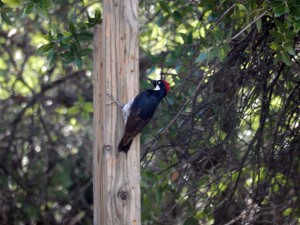
Finally it was time to head home. All in all, a short, but great trip. I was happy with my gear organization, the new Mountain Hardware Optic 3.5 Tent was a joy (see short review below), the weather was great, and I didn’t get Eloise mad at me. The route between our house and the canyon is an easy drive, so I can see us popping down here from time to time for a night or two – if we keep our gear organized, we could go down on pretty short notice.
Mountain Hardware Optic 3.5 Backpacking Tent. Described as a 3+ person tent. It was spacious and quite airy, given its four-sided mesh screen construction. There are doors on adjoining sides that roll back to offer huge views and easy access; the rainfly covers these adjoining doors (see photo set) to offer easy access and ventilation. It was easy to put up and take down. The only negative is that the seam on the rainfly tore at the only tie-down point that was not reinforced as well as every other tie-down point on either the rainfly or tent. Odd, to say the least.
TOTAL TRIP MILEAGE: 102.0 miles.
Friends of Madera Canyon: A non-profit organization dedicated to assisting the U.S. Forest Service in advancing historical, scientific, educational, and interpretive programs in Madera Canyon
Black Butte is a dacite dome volcano that is just north of the city of Mount Shasta, sitting alongside Interstate 5. The summit tops out at 6,358 feet. Having been born in Mount Shasta and lived in Weed for the first five years of my life, and spending time over the years with various relatives still in the area (my parents moved back to area 10 years ago), I have always wanted to climb Black Butte. Frankly, I don’t know what took me so long.
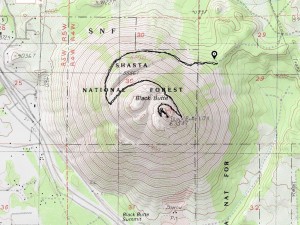
The trailhead is on the east side of the mountain. Driving north out Mount Shasta up the Everett Memorial you come to sign directing you west to the Black Butte trailhead. It’s a 3.3 mile drive on a decently maintained Forest Service road to the trailhead. I got there about 7:15 am. No one else there. It was 44 degrees outside, with a 10 mph gusts of wind. All in all, not a bad morning to make the hike. The first quarter mile of the hike is in trees, but when you pop out, and look up at the side of the mountain, it’s imposing. The slope is chunks of broken dacite, at a 45 degree angle. Basically you loop around the mountain counterclockwise from east to west side of the mountain, then the trail turns and goes back east until you come to a few little switchbacks near the top. A lot of the trail is scree, but you can move fast. Once you get near the top, it flattens out somewhat. The last 50 feet or so to the summit, where the foundation of the old fire lookout is, is a scramble. It was a bit windy on top, but still breathtaking. Mount Shasta looms to east and Mount Eddy to the west. It was cloudy and cold on top, so I didn’t linger too long. I couldn’t find a summit register, and I didn’t bring anything up to use as one.
I made the trip up in 2 hours, and back done in 1 1/2. My elevation gain going up was 1,807 feet. I met a lone hiker on the way down, but that was it for human contact.
Geology facts: Dacite is a gooey form of lava that generally flows very slowly.
The word dacite comes from Dacia, a province of the Roman Empire which lay between the Danube River and Carpathian Mountains (now modern Romania and Moldova) where the rock was first described. Lassen Peak is made of dacite, and is one of the largest plug domes in the world. The famous plug of Mount Saint Helens is also dacite, as are most of the lavas of Kīlauea.
Wikipedia: Black Butte (Siskiyou County, California)
summitpost.org: Black Butte (CA)
After years of planning and training, the time had come to tackle one the of peaks on my list – Tucson (City) High Point. After making sure I was provisioned, that my estate was in order, funds in place to cover the cost of a helicopter evac from the summit, and that I had cleared my browser history, I kissed my wife goodbye and set out for the far flung eastern corner of the Tucson corporate limits to make my ascent.
After parking the at the trailhead, the most daunting of obstacles presented itself – barbed wire fencing – damn! I’m in a good pair of jeans. Nonetheless, I was determined to forge ahead. Gently placing a hand upon the top strand, I pushed down and was able to get over without ripping new ventilation into my garments. Ahead I could see the summit. My goal was in sight. Putting one loafer encased foot after another, I deftly made my ascent in almost no time at all – about 1 second. After spending some time on the peak and logging in on the register, I made my way off the mountain to celebrate another peak bagged!
In all seriousness, this high point is listed on peakbagger.com, and is on the list of selected USA Selected City High Points. It is literally at the most far eastern corner of the Tucson corporate boundary. It is also a pimple on the surrounding desert. The high point is located at the northwest corner of the intersection of E Dawn Drive and E Shalom Dr in the Vail area.
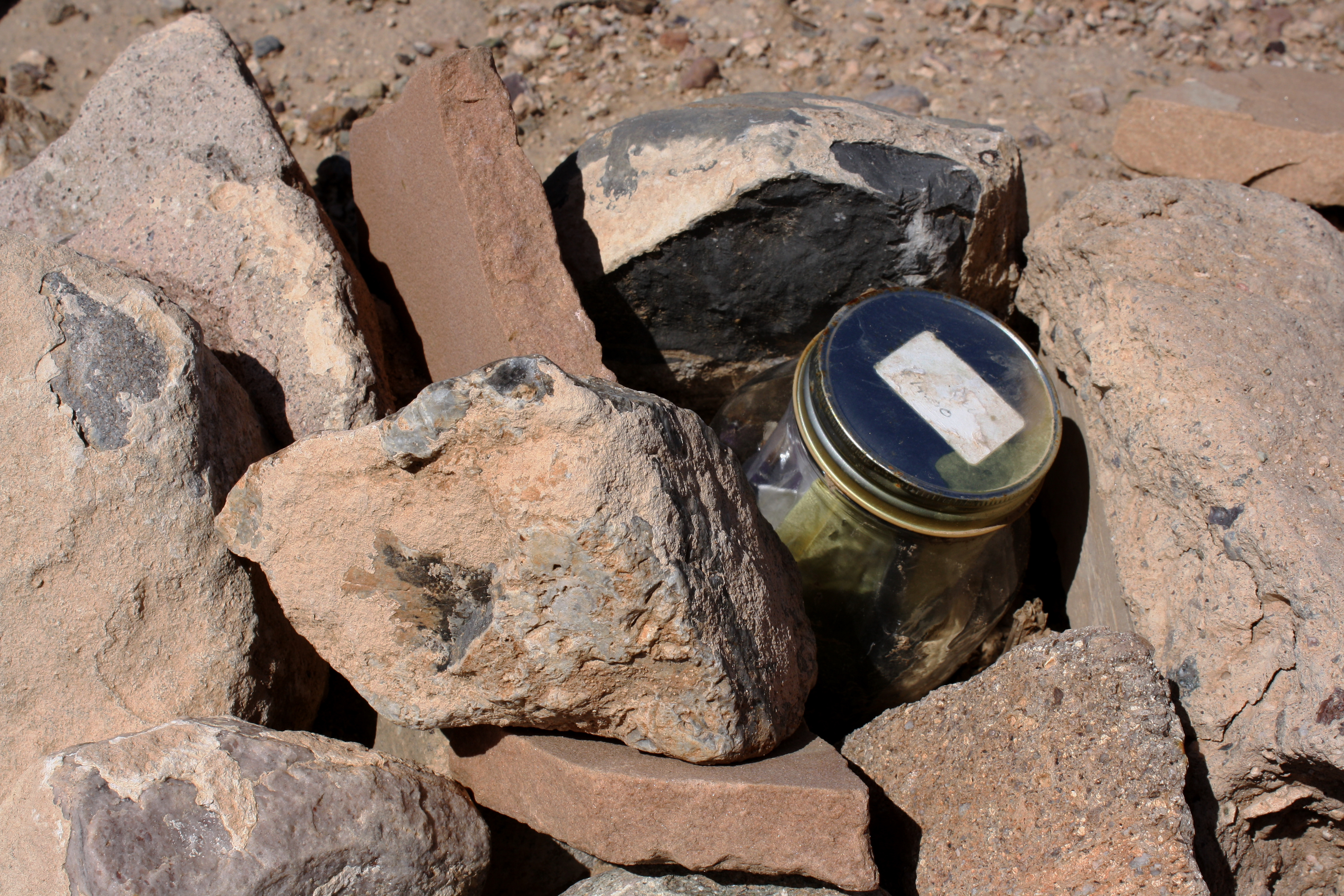
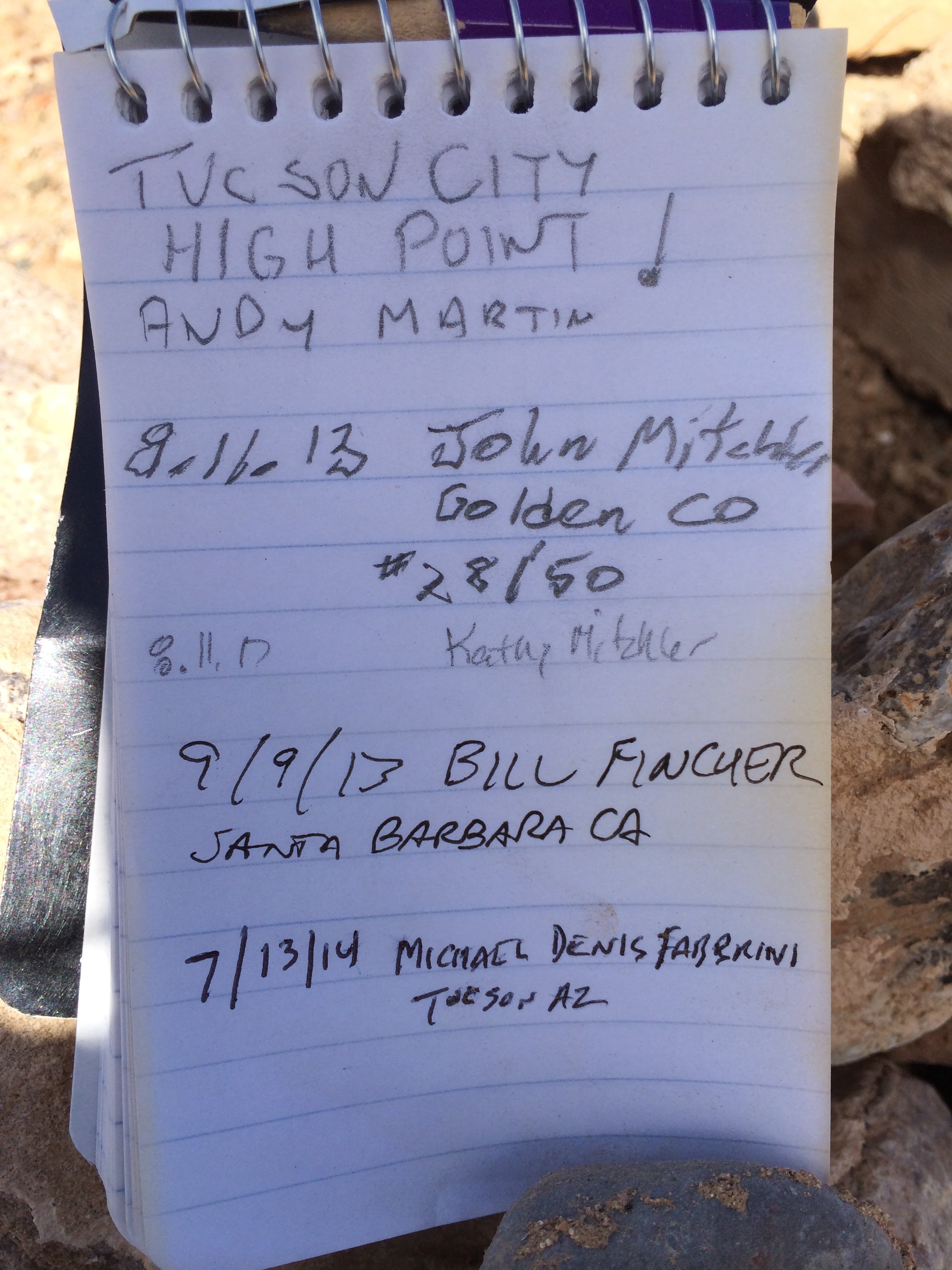
This trip report was originally published at HikeArizona.com